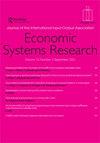从最终需求的角度管理中国铅排放
IF 1.6
4区 经济学
Q2 ECONOMICS
引用次数: 1
摘要
铅污染是严重的环境和健康风险,是中国面临的主要挑战。本文采用多区域投入产出模型,从生产和最终需求的双重视角对中国大气铅排放进行了分析。我们的研究结果表明,山东、河北和湖北的直接排放量占全国的36%以上。然而,从最终需求的角度来看,一些发达省份,如江苏、广东和浙江,通过省际贸易将排放转移到其他省份,导致了相当大比例(29%)的全国排放量。贸易排放通常从内陆地区流向更富裕的沿海地区(如河南-江苏、安徽-江苏、湖南-广东)。考虑到生产和最终需求,我们确定了各省在铅排放管理中的不同角色。富裕的受益省份应该承担更多的责任,将先进技术,特别是煤炭选矿等行业的先进技术,转移到牺牲省份。图形抽象本文章由计算机程序翻译,如有差异,请以英文原文为准。
Managing lead (Pb) emissions in China from the perspective of final demand
Lead (Pb) pollution is a serious environmental and health risk and remains a major challenge for China. This study analyzes China’s atmospheric Pb emissions from the dual perspectives of production and final demand, by integrating localized emission factors and a Multi-Regional Input – Output model. Our results show that Shandong, Hebei, and Hubei directly contribute over 36% of the national emissions. However, from the final demand perspective, some developed provinces, such as Jiangsu, Guangdong, and Zhejiang, induce a considerable proportion (29%) of the national emissions by relocating emissions to other provinces through inter-provincial trade. Trade-embodied emissions typically flow from interior regions to more affluent coastal regions (e.g. Henan-Jiangsu, Anhui-Jiangsu, Hunan-Guangdong). Considering both production and final demand, we identify different roles for provinces in Pb emission management. Prosperous beneficiary provinces should take more responsibilities by transferring advanced technologies, especially those in industries such as coal dressing, to sacrificial provinces. GRAPHICAL ABSTRACT
求助全文
通过发布文献求助,成功后即可免费获取论文全文。
去求助
来源期刊

Economic Systems Research
ECONOMICS-
CiteScore
5.60
自引率
4.00%
发文量
17
期刊介绍:
Economic Systems Research is a double blind peer-reviewed scientific journal dedicated to the furtherance of theoretical and factual knowledge about economic systems, structures and processes, and their change through time and space, at the subnational, national and international level. The journal contains sensible, matter-of-fact tools and data for modelling, policy analysis, planning and decision making in large economic environments. It promotes understanding in economic thinking and between theoretical schools of East and West, North and South.
 求助内容:
求助内容: 应助结果提醒方式:
应助结果提醒方式:


